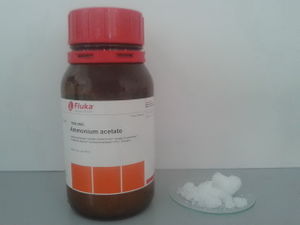Ammonium acetate

| |
| Names | |
|---|---|
| IUPAC name
Ammonium ethanoate
| |
| Systematic IUPAC name
Ammonium acetate | |
| Other names
Azanium acetate
| |
| Identifiers | |
| Jmol-3D images | Image |
| |
| Properties | |
| CH3COONH4 C2H7NO2 | |
| Molar mass | 77.08 g/mol |
| Appearance | Deliquescent white solid |
| Odor | Acetic |
| Density | 1.17 g/cm3 (20 °C) 1.073 g/cm3 (25 °C) |
| Melting point | 110–114 °C (230–237 °F; 383–387 K) (Decomposes) |
| Boiling point | 117.1 °C (242.8 °F; 390.2 K) (At 760 mmHg, decomposes) |
| 102 g/100 mL (0 °C) 148 g/100 mL (4 °C) 143 g/100 mL (20 °C) 533 g/100 mL (80 °C) | |
| Solubility | Reacts with strong acids Soluble in acetone, ammonia, ethanol, sulfur dioxide |
| Solubility in dimethylformamide | 0.1 g/100 g |
| Solubility in methanol | 7.89 g/100 ml (15 °C) 131.24 g/100 ml (94.2 °C) |
| Thermochemistry | |
| Std enthalpy of
formation (ΔfH |
−615 kJ/mol |
| Hazards | |
| Safety data sheet | ScienceLab |
| Flash point | 136 °C |
| Lethal dose or concentration (LD, LC): | |
| LD50 (Median dose)
|
386 mg/kg (mice, intravenous) |
| Related compounds | |
| Related compounds
|
Ammonium formate |
| Except where otherwise noted, data are given for materials in their standard state (at 25 °C [77 °F], 100 kPa). | |
| Infobox references | |
Ammonium acetate is a chemical compound with the formula NH4CH3COO (sometimes written as CH3COONH4).
Contents
Properties
Chemical
Ammonium acetate decomposes at temperatures above 165 °C to yield acetamide:
- CH3COONH4 → CH3C(O)NH2 + H2O
If acetamide is heated further, in the presence of a drying agent, it will convert to acetonitrile (methyl cyanide).
Physical
Ammonium acetate is a white hygroscopic solid. Ammonium acetate is volatile at low pressures and has a vinegar-like smell.
Availability
Ammonium acetate can be purchased online cheaply.
Preparation
Ammonium acetate can be prepared by reacting acetic acid with ammonia, ammonium bicarbonate or carbonate. Drying the solution by boiling the excess water is difficult, as ammonium acetate will decompose if the temperature is uneven. Heating the solution on a water bath at below 90 °C is an option, though a bit of ammonium acetate will decompose, causing the solution to darken. This isn't much of a problem, as the contamination will not precipitate when recrystallizing the acetate from the solution, and can be removed by vacuum filtering the crystals and wash them with cold water or acetone.
The best way to synthesize ammonium acetate, with insignificant product loss, is to bubble ammonia gas into anhydrous (glacial) acetic acid, which causes the ammonium acetate to crystallize and crash out of the acetic acid. Filter the wet crystals and sir dry them. While attractive, this method relies on using gaseous ammonia which means you'll need a more complicated system, than simply dumping an ammonium salt in acetic acid.
Projects
- Acetamide synthesis
- Acetonitrile synthesis
Handling
Safety
Ammonium acetate is non-toxic, though if strongly heated it can generate acetamide which is considered carcinogenic.
Ammonium acetate is hygroscopic and will slowly hydrolyze to yield acetic acid, which is irritant and corrosive in large quantities.
Storage
Ammonium acetate should be stored in sealed containers, in a dry place, as it's hygroscopic.
Disposal
Ammonium acetate is a harmless source of nitrogen to organic life and can be discarded without any special treatments.
References
Relevant Sciencemadness threads
- Chemical pages without CAS Registry Number
- Articles without EBI source
- Chemical pages without ChemSpiderID
- Chemical pages without DrugBank identifier
- Articles without KEGG source
- Articles without InChI source
- Articles without UNII source
- Articles containing unverified chemical infoboxes
- Chemical compounds
- Organic compounds
- Ammonium compounds
- Buffering agents
- Easily prepared chemicals
- Acetates